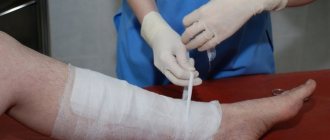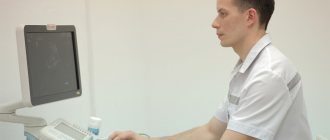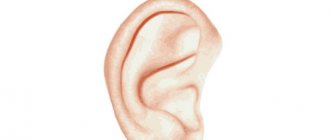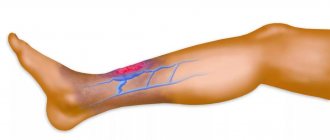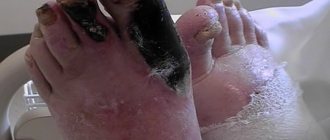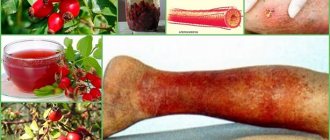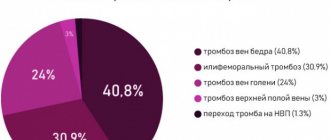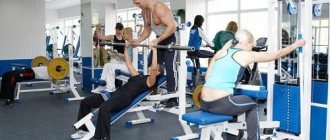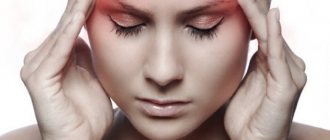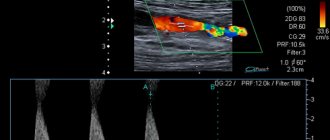Features of the procedure
Lymphatic drainage, as a technique for effective therapeutic effects on the lymphatic system of the human body, arose in the last century in France. As initially, the main effect of the procedure is the restoration of the natural movement of lymph to all limbs and vital systems of the body.
Lymph is a component of the blood that helps remove toxins and other substances that inhibit the normal functioning of the body, nourishes cells and protects them from infectious lesions. Disruption of this work in a person’s limbs can provoke the development of varicose veins, swelling, and heaviness in the legs.
The massage in question helps solve these problems. It has a positive effect on lymph nodes, blood vessels and capillaries, relieves congestion, and generally promotes healthy limbs.
Forms and causes of lymphostasis
Lymphostasis of the lower extremities may have the following causes:
- due to serious pathological processes in the kidneys;
- heart failure;
- dilation of veins as a result of varicose veins;
- abnormalities in the lymphatic system itself;
- damage to lymphatic vessels caused by various types of leg injuries;
- venous insufficiency;
- disruptions in the endocrine system;
- formed malignant tumors in the lower extremities of a person that interfere with lymph flow;
- the presence of parasitic organisms (this reason is most often found in places on the planet with a hot climate);
- medications that can cause swelling of the limbs as a result of side effects;
- sedentary lifestyle;
- insufficient amount of proteins in the human body.
In fact, today there are many reasons for the appearance of this disease.
In addition, it is extremely important to identify it as quickly as possible, since this will avoid unpleasant consequences. Lymphostasis, or as lymphedema of the lower extremities is also called, can occur in a person in two forms:
Lymphostasis, or as lymphedema of the lower extremities is also called, can occur in humans in two forms:
The primary cause of the leak. Develops as a result of congenital abnormalities in human lymph nodes. In this case, the disease may affect one or both legs at once. Typically, the primary form begins to manifest itself in childhood, and only progresses over time. That is, already in adolescence, the disease can progress to its maximum level.
Secondary cause of leakage. In this case, the disease develops as a result of various pathogens or mechanical trauma that damages the lymphatic vessels. Usually the disease develops only on one limb, but in rare cases there are exceptions. But leg swelling is also often localized from the foot to the kneecap.
In addition, the disease is divided into three degrees of complexity:
- First stage. It is characterized as mild swelling, which can be cured quite easily.
- Second stage. It is characterized by irreversible swelling, which can only be eliminated with surgery.
- Third degree. In this case, the so-called elephantiasis develops, that is, the swelling becomes quite large and cannot be treated.
Contraindications
According to doctors, the procedure cannot be performed in the following cases:
- the presence of open wounds, fresh scars at the site of exposure;
- vein thrombosis;
- oncology;
- diabetes;
- general malaise, fever.
How is it carried out?
Many people prefer to do lymphatic drainage massage at home on their own. Typically this method requires 15 procedures. It is advisable to carry them out every other day. For each leg, the maximum recommended session duration is 7 minutes.
The procedure is carried out in several stages.
- Find a comfortable position in a chair or chair. The most suitable furniture is an ottoman to sit on, as well as a footrest. It should be positioned so that your legs are above the level of your pelvis.
- Apply massage cream or balm to your feet using circular movements, which should be done gently. Thus, the massaged area will warm up and the movement of lymph through the ducts will accelerate.
- The first area of massage is the area from the knee joint to the hip. Using the edge of your palm, you need to make a sliding type movement along the thigh area, gradually increasing force.
- Next, you need to carry out patting movements on the thigh in the direction from bottom to top. This will stimulate blood circulation.
- Then you need to massage the lower part of the leg - from the toes and towards the knee. Stroking should be intense.
- Next, you should grab the shin with both hands and perform movements like squeezing in the direction from bottom to top.
- The feet are massaged by pressing towards the ankle and rubbing. The whole procedure is carried out with the pads of the fingers, which gradually move up the leg.
- After the massage, you should not suddenly stand upright. You need to lie down for several minutes. It is advisable that the level of the legs be higher than the level of the head.
There is also a special recipe for such a massage using ingredients such as honey and oil.
You can carry out this procedure correctly by using the instructions.
- A couple of tablespoons of natural bee honey are diluted with a few drops of aromatic oil.
- Next, cover your palms with the resulting mixture.
- Afterwards, the palms are pressed against the surface of the legs, and then abruptly torn off. This way, it is possible to distribute the honey mixture evenly and help it to be absorbed into the skin.
- Over time, the hands will begin to stick more strongly to the lower limbs. The honey will also acquire a darker shade and thicker consistency and will begin to be removed from the skin in the form of pellets.
- To make the result more effective, after completing the massage procedure, an anti-cellulite agent should be applied to the skin.
A special feature of this procedure is the adaptation period. At first there may be some pain. In addition, such a massage is difficult to do on your own.
How to properly perform lymphatic drainage massage
The massage procedure will be more effective if you consider the following points:
- Absence of pain - massage should be a joy; the presence of pain indicates a violation of technique or the presence of hidden problems.
- Using oils or creams - cosmetics will make the skin more pliable, in addition, the epidermis will receive additional nutrition and hydration. Natural ingredients are also acceptable: honey, ground coffee, decoctions of medicinal plants.
- A bath before a massage is relaxing; with the addition of ethers, the procedure will prepare and warm up the skin.
- Drinking fluids - 2-3 liters of water per day - is the key to a successful massage. Please note that it is not recommended to drink water within 2 hours after the session.
- Playing sports - physical activity will enhance the effect of massage, tighten the skin, make it more elastic, and generally help adjust your weight and body.
How does lymphostasis of the hand manifest?
Depending on the stage of the pathological process, a person with lymphostasis experiences certain symptoms:
- At the first stage, the manifestations are quite minor. The patient may notice slight pastiness or swelling of the hand. But this phenomenon is transient, intensifies in the afternoon and evening, and disappears after a night's rest. Since this does not bother the patient too much, he, as a rule, does not go to the doctor. It is at this stage that it is easiest to provide help, since lymphostasis is reversible.
- In the second stage, the swelling becomes denser, connective tissue fibers begin to grow, and the skin hardens. Since it is stretched as a result of dense swelling, painful sensations appear, and this forces the patient to seek help for lymphostasis of the arm. At this stage, it is still possible to cure the pathology, but this process requires a long time and pedantic adherence to the recommendations given by the attending physician.
- The third stage is the most severe, as irreversible changes begin in the hand, all signs intensify. The skin of the upper limb becomes covered with wounds, and deformation of the fingers begins. The hand increases in size so much that it becomes impossible to perform the usual work with it. In some cases, the patient develops erysipelas. Multiple complications lead to a person becoming disabled and may even die.
Latest information: Venous valve role and structure
Manual lymphatic drainage
There are three types of manual lymphatic drainage massage technique based on penetration strength:
- Superficial – affects the capillaries responsible for collecting fluid. Suitable for solving cosmetic problems, tightens the skin, makes it smoother. The technique involves light circular stroking of the legs, starting from the feet and gradually rising to the hips, with slight pressure on the muscle tissue.
- Deep - affects the lymph vessels responsible for removing excess fluid. It is used to treat various diseases of the limbs, promotes weight loss and figure correction. The technique involves a more intense effect on problem areas, stimulating the deeper layers of muscle tissue.
- Interior – affects the lymph nodes. Allows you to restore their functionality, ensuring the health of the body as a whole.
For a home session, the first type of massage is best suited; it is the safest and does not require special knowledge of human anatomy. Deep and internal - it is better to entrust it to specialists.
Indications for the procedure
Lymphatic drainage is used to prevent and treat many diseases and eliminate pathological conditions. It is advisable to undergo a massage course if:
- varicose veins of the extremities;
- swelling;
- dysfunction of metabolic processes;
- violations of lymph movement;
- excess weight (to speed up weight loss and figure correction);
- cellulite;
- low mobility;
- wearing tight or uncomfortable shoes;
- muscle pain;
- heaviness and fatigue of the legs.
Attention! Regular lymphatic drainage massage after 40 years prevents the development of varicose veins and trophic ulcers.
For lymphostasis
Lymphatic drainage massage of the legs at home allows for maintenance therapy of lymphostasis - a disease associated with the occurrence of constant swelling of tissues, provoked by dysfunction of the outflow of tissue fluid.
Most often, this disease affects the lower extremities, but massage is also recommended in the upper area so that the disease does not progress. The session begins with superficial stroking of the legs from the feet to the thighs according to the movement of the lymph flow with slight pressure on the skin. This allows you to prepare the limbs for a more intense procedure and increases blood flow.
Next, massaging the skin becomes more rhythmic, but at the same time gentle and light. The pressure should not cause discomfort or pain. The duration of one session is 40–60 minutes. Duration of therapy – 10 times every other day.
After the procedure, it is recommended to use special compression garments, which will enhance the effectiveness of the massage.
In the second and third degrees, lymphatic drainage foot massage is contraindicated!
Result: lymph flow is activated, metabolism is increased, which helps reduce swelling, as well as increase the overall level of immunity.
Don't miss the most popular article in the section: Hyaluronic acid in tablets. Benefits, how to take, reviews from doctors and effectiveness.
Hardware massage
This type of physiotherapy can be combined with a manual one. Hardware therapy consists of using a special compression cuff with increased pressure. Air is pumped into it, and it expands and begins to put pressure on the problem points of the limb.
There are many types of devices that have different effectiveness, but without exception they all help eliminate edema. These procedures allow you to normalize lymphatic drainage by creating natural conditions for this.
For varicose veins
Varicose veins are a leg disease characterized by swelling, pain in the limbs, and the appearance of spider veins.
There are three stages of this disease:
- the first is the appearance of slight swelling, heaviness in the legs after a hard day, pain in the lower leg area;
- the second is increased pain and swelling, the appearance of a vascular network, especially noticeable under the knees, where the skin is thinnest;
- third - large veins begin to appear outward, lumps and knots appear, the legs swell and constantly hurt.
Lymphatic drainage is allowed in the first and second stages. You can carry out the procedure yourself if there are initial signs of varicose veins; other cases require specialist supervision.
The session begins by applying a special venotonic cream to the skin, which will not only provide easy gliding, but will also have a therapeutic effect: strengthen the walls of the veins, improve blood circulation, and relieve swelling.
Technique:
- Light stroking movements in the direction of lymphatic flow (from bottom to top), warming the skin and increasing blood circulation.
- Kneading the tissues with a gradual increase in the load on the muscles. The movements are smooth; sharpness can provoke vasospasm.
- Light patting movements that relax and complete the massage procedure.
Course of therapy: duration 30 minutes for 2 weeks. Then you need to take a break for 4 weeks, after which you can repeat the procedure.
Symptoms of lymphostasis
Symptoms of lymphostasis of the lower extremities at the initial stage are characterized by the appearance of slight swelling of one or both legs, which can often appear closer to the evening. However, after resting by the morning, previously noticed swelling may disappear. But swelling can also be observed after prolonged stress on the legs.
If the disease begins to progress, the following symptoms can be observed:
- swelling appears that does not disappear;
- after a certain time, the swelling may increase in size;
- skin tension on the legs occurs;
- pain may occur;
- rapid fatigue of the legs.
Anyone who experiences similar symptoms should seek medical help immediately. After all, if there are symptoms of a diagnosis of lymphostasis of a similar nature, then it can easily be eliminated at this stage.
If treatment for lymphostasis of the lower extremities is ignored, complications may arise that will greatly spoil a person’s quality of life. A disease such as elephantiasis may develop, which sharply reduces the mobility of the legs, and sometimes even leads to a wheelchair.
A person may also have the following complications:
- the occurrence of ulcers;
- the appearance of itching and rash of the skin;
- joint disease.
In addition, in rare cases, death is possible due to the possible occurrence of sepsis (blood poisoning).
Decongestant massage
Lymphatic drainage massage helps relieve swelling and fatigue in the legs after a hard day at work, and you can do it yourself at home.
Before the session, it is recommended to take a relaxing bath, which will prepare the limbs for further actions. An infusion of birch leaves, mint, and chamomile is added to warm water (100 g of plant mixture per 1 liter of liquid). The duration of the procedure is 15–20 minutes. Then the feet are wiped well and lubricated with a massage cosmetic.
At the first stage, massage each toe, not bypassing the hollows between them. The second stage goes up to the ankles and calf muscles, ending with massaging the knees and thighs.
The movements are all smooth, light, with slight pressure on the tissue, accompanied by patting and tapping. If redness appears during the massage, the force of the effect must be weakened.
Please note that the lower leg is worked by squeezing and unclenching the muscle tissue, combining these movements with kneading the Achilles tendon. When working the knee joint, you should not massage the popliteal area. The session ends with light stroking of the limbs for 2 minutes.
Course of therapy: duration of the procedure is no more than 30 minutes for 10 days every month. This massage is a good prevention for the development of various leg diseases.
Lymphatic drainage for legs
Treatment of lymphedema must be comprehensive. The treatment program includes several important components:
- manual massage
- pneumatic compression
- bandaging (bandaging in a special way)
- Maintenance therapy: skin care, wearing compression stockings, self-massage, exercise, diet
Thus, patients undergo manual and hardware lymphatic drainage of the legs, which helps remove excess fluid, and then patients must follow all the doctor’s recommendations to maintain the achieved result. Courses of treatment must be repeated, the frequency of repetitions is determined by the attending physician.
Please note that medications for lymphatic drainage of the legs are not prescribed. Surgical treatment is performed in extreme cases; the majority of patients undergo conservative therapy.
Lymphatic drainage massage with oil and honey
Lymphatic drainage massage with honey will help improve blood circulation, smooth and tighten the skin. The natural ingredient will nourish the epidermis with beneficial substances and, at the same time, eliminate toxins and harmful elements.
For massage, you need to take fresh honey of any kind and mix it with your favorite aroma oil at the rate of 1 tsp. sweet ingredient + 5 drops. oils
Please note that the mixture is prepared immediately before the session.
The honey-oil mixture is applied to problem areas with light patting movements. Then the movements become more intense: the palms are pressed tightly against the skin and abruptly torn off. The massage is continued until a whitish coating appears on the hands; in time equivalent, this takes from 5 to 10 minutes.
After the procedure, the remnants of the honey-oil mixture are washed off with warm water, and the skin is lubricated with a suitable cosmetic product. Number of sessions – 15 over 30 days.
Treatment
The main goal of treating lymphedema is to restore the flow of lymph from the limbs and other areas that it has affected. The disease is treated with manual lymphatic drainage massage, physiotherapy, wearing special underwear (similar to compression underwear for varicose veins) and medications. Also, with this pathology, the patient should follow a diet and limit salt intake. He will benefit from physical therapy and swimming lessons.
Surgical intervention for the disease is carried out if complex conservative therapy does not bring benefit, the patient has fibrosis.
Drugs
Taking medications for lymphostasis is advisable only in the initial stages of its development, when there are still no structural changes in the tissues and dermis. Also, drugs can be prescribed in the postoperative period.
The main goal of drug therapy is to reduce the production of lymphoid fluid and restore its free movement through the vessels. The doctor may prescribe the following medications to the patient:
- Detralex, Troxevasin (venotonics to improve lymph circulation and blood microcirculation, which is especially important if varicose veins are also present).
- Coumarin, nicotinic acid (to ensure the removal of lymphoid fluid from the interstitial space).
- Teonicol, No-shpa, Drotaverine (to normalize blood circulation in the vessels).
- Antibacterial drugs (prescribed when infections occur; the choice of medication depends on the type of pathogen).
- Furosemide (diuretic drug). For a milder diuretic effect, herbal teas are sometimes prescribed. You can find out which herbs have a diuretic effect here.
- Troxerutin, Reopirin (medicines that ensure the normalization of metabolic processes in the body).
- Curantil (blood thinner).
- Lykopid, succinic acid (medicines for stimulating immune functions).
- Heparin, Warfarin (anticoagulants, necessary to improve the rheological properties of blood).
- Wobenzym, Flogenzym (enzyme preparations, have an anti-inflammatory effect, reduce swelling).
- Lymphomyosot (a homeopathic remedy used to improve the flow of lymph through the vessels and stimulate metabolism).
Massage
To eliminate stagnation of lymphoid fluid, massage is performed. It is relevant in the initial stages of the disease and may become the only method of therapy. In the later stages of lymphostasis, massage is included in complex treatment.
The result of this method is the narrowing of lymphatic vessels, improving lymph circulation. Massage can be performed by specialists or done at home yourself:
- The procedure should begin with light circular stroking of the sore limb. Movements are carried out only in the upward direction.
- Next, the affected area is kneaded, patted and rubbed. All movements alternate with stroking.
- The massage session also ends with stroking.
Massage for lymphostasis is carried out in a course of two weeks. Between courses there are breaks of 1-2 weeks. At this time, you can do a self-massage for swelling. If the disease is accompanied by increased accumulation of interstitial lymphoid fluid, then massage should only be performed by a specialist. Areas with trophic ulcers and venous compactions are not massaged.
Compression underwear
Wearing compression garments allows you to improve lymphatic and venous drainage, reduce the accumulation of protein metabolism products in tissues, ensure the correct position of the limbs, control its volume, maintain the skin, and protect it from injury.
This type of therapy is used in combination with other non-surgical methods of treating lymphedema. For the treatment of lower extremities with pathology, elastic knee socks are used; if the arms are affected, special sleeves are worn.
There are four types of compression; therefore, the type of underwear should be prescribed by the attending physician. Properly selected compression garments do not cause discomfort when worn.
Physiotherapy
Physiotherapy is useful for lymphostasis, which is accompanied by numbness of the limbs. Also, their various types help normalize the flow of lymphoid fluid.
The most effective methods of physiotherapy for the disease are:
- magnetic therapy;
- hydromassage;
- acupuncture;
- laser therapy;
- pneumomassage;
- taping.
Exercise therapy
When you are sick, it is useful to perform special physical exercises. Classes are held two or more times during the day and are selected individually by the attending doctor. When performing them, you must wear compression garments.
Doctors usually recommend the following types of exercises:
- Bend and straighten the fingers on the sore limb.
- Play the “bicycle”.
- Rotate your feet one at a time in different directions.
- Draw figure eights in the air with your feet.
Diet
With lymphostasis, you need to adhere to a diet that allows you to reduce excess weight, improve the circulation of lymphoid fluid, and eliminate stagnation in tissues. A patient with illness should adhere to the following nutritional principles :
- The menu should include foods high in fiber.
- Salt intake should be reduced.
- The diet should contain food with a large amount of plant and animal proteins.
- Coffee and alcoholic beverages should be removed from the menu.
- You need to eat up to six times a day, but in small portions.
- Liquids must be drunk in sufficient quantities.
The above nutritional principles are suitable for dietary table No. 10, developed by scientist M.I. Pevzner. This diet is also intended for patients suffering from pathologies of the cardiovascular system.
Operation
If drug therapy is powerless, or the disease is in a severe stage, then surgical treatment is prescribed, which involves performing one of the following types of surgery:
- Tunneling. In this type of surgery, the doctor creates small holes in the affected areas. Through them, lymphoid fluid is released into healthy tissues, then absorbed by blood vessels. To make temporary tunnels, spiral prostheses are used. To create permanent drainages, drainage made from inert materials is used.
- Liposuction. The surgeon excises part of the subcutaneous tissue that has undergone fibrotic changes.
- Dermatofasciolipectomy. In this type of surgical intervention, the island technique is used. The doctor removes the affected areas of the dermis, fibrous tissue, fascia and a layer of fat. Before this operation, liposuction is performed to remove subcutaneous tissue. Wound surfaces are covered with skin transplanted from healthy parts of the body.
- Creation of lymphovenous anastomosis. Used for secondary forms of pathology. The technique involves connecting the vessels and the adjacent vein using the finest microanastomoses.
After any of the above surgical interventions, the patient needs drug treatment. Also, the patient must regularly visit an angiosurgeon and adhere to supportive therapy measures throughout his life.
Folk remedies
Remedies prepared according to folk recipes cannot be used as a full-fledged treatment, but they are often used as an auxiliary therapy. The most famous are:
- Grinding from water with the addition of vinegar. The ingredients are mixed in proportions of one to two. The resulting composition is used during massage therapy sessions. After the procedure, the skin is washed with warm water and lubricated with cream.
- Infusion of dandelion leaves. Pour two tablespoons of the ingredient into 500 ml of boiling water and let it brew overnight. The finished composition is filtered and taken 100 ml per day, dividing into parts. The product helps to tone the walls of blood vessels and enhance the flow of lymphoid fluid.
- Tar compress. Pharmaceutical tar is mixed with baked onions. The resulting composition is distributed onto a gauze bandage and applied to the sore spot, secured and left overnight.
- A decoction of rose hips, nettles and birch buds. The plants are mixed in equal parts and cooked in a steam bath for 20-25 minutes. Next, the drink is infused, filtered and taken 100 ml per day before meals. Regular use of this drug will help get rid of swelling in the limbs. Instead of decoction, you can also brew tea for swelling according to the recipes given on the pages of our website.
- Herbal decoction compress. A decoction of St. John's wort, plantain and yarrow, mixed in equal parts, is prepared. Add 20-25 ml of alcohol and a tablet of acetylsalicylic acid to the resulting liquid. The finished composition is soaked in gauze and applied to the affected area, then the compress is secured with a bandage and left overnight.
- Rye flour compress. The ingredient is brewed in boiling water and allowed to brew for 20-25 minutes. During this time, the flour swells, kefir is added to it, and the composition is mixed. The finished mass is distributed over gauze and applied to the sore spot, secured with a bandage. Keep the compress for about two hours, do it twice a day.
- A mixture of honey and garlic. 250 g of garlic are crushed using a grater, pour in 350 ml of honey, and mix the composition. The resulting mass is sent to infuse for a week. Next, take one large spoon three times a day forty minutes before eating.
- Plantain infusion. Two large spoons of the plant should be poured with two glasses of boiling water. Let the mixture sit overnight, then strain. The finished drug is taken half an hour before meals, one hundred grams at least four times a day. The course of therapy is approximately two months.
- Leeches. If swelling is not pronounced, then two or three leeches can be used for treatment. They contain hirudin, which serves as a blood thinner and strengthens blood vessels.
- Baths with a series. Six large spoons of the plant are poured with two liters of boiling water and cooked on the stove for about 5-7 minutes. The resulting decoction is added to the bath. Taking such baths improves the condition of the skin during lymphostasis.
- Liquorice root. Ten grams of the crushed ingredient is poured into a glass of boiling water, kept in a water bath for about 30 minutes, then allowed to cool, filtered and water added to the original volume. Drink the product three times a day, one large spoon. The course of therapy is at least two weeks. The drug helps to enhance lymphatic drainage and cleanse the lymphatic system.
Hardware lymphatic drainage
Lymphatic drainage massage of the legs at home is not always effective, especially in cases of progression of any disease of the lower extremities.
Then experts recommend using a hardware method, which comes in three types:
- microscopic currents;
- compressed air therapy;
- vacuum.
Hardware lymphatic drainage contracts the walls of blood vessels, rather than simply squeezing them, therefore, the process of restoring lymph movement is accelerated, returning the legs to their former health.
Indications: cellulite, swelling of the lower extremities, initial stage of varicose veins, enlarged lymph nodes, excess weight.
Contraindications: presence of skin diseases, oncology, tendency to blood clots, while expecting a child or lactation.
Recommendations during treatment
To improve your condition during treatment, you should follow certain recommendations. And, above all, they relate to proper nutrition. Lymphostasis often develops against the background of obesity, so if you are overweight, you should avoid high-calorie foods (animal fats, smoked meats, canned food, sausages). It is best to consume fresh fruits and vegetables. You can diversify your diet with porridges, but only those cooked from whole grains.
You can eat low-fat fermented milk products, but butter should be limited. It is best to cook food by steaming or boiling. The diet should not exclude vitamins and beneficial elements. You should get up from the table feeling slightly hungry. Meals should be frequent, but in small portions, 4-5 times a day. Two hours before bedtime, you can drink low-fat yogurt or kefir.
It is necessary to get full rest (about eight hours a day), and do not go to bed later than 11 pm. Before going to bed, you should carry out hygiene procedures, as well as pour warm water over the sore limb and perform self-massage. The hand must be protected from possible injury.
You need to have a separate pillow for your sore arm, and you should sleep on your healthy side. In the morning, it is best to do a light workout, and after breakfast take a walk. If lymphostasis of the arm began after a mastectomy, then the woman is not recommended to wear a prosthesis with a bra at home. You should also avoid tight and tight-fitting clothing. If necessary, blood pressure measurements should be carried out only on a healthy limb, and some household chores should be entrusted to close people. This is especially true for work that requires staying in a static, inclined position.
Microcurrents
Hardware lymphatic drainage with microcurrents is a superficial procedure. Light electrical impulses affect the lymphatic vessels, evenly squeezing them, which has a beneficial effect on the movement of lymph.
The procedure also causes muscles to contract, which helps tighten the skin and restore their tone. In addition, microcurrents affect the nervous and other systems of the body, healing them.
Advantages of this procedure:
- suitable for thin and sensitive skin;
- trains small vessels and capillaries;
- smoothes and moisturizes the epidermis;
- has a calming effect.
Microcurrent massage has additional contraindications:
- presence of a pacemaker;
- heart diseases;
- suffering a heart attack or stroke;
- the presence of metal implants in the problem area.
The essence of microcurrent massage: the working area is lubricated with a special gel that allows electrical impulses to be carried out, and two electrodes are installed - with positive and negative charges. The first remains in place, and the second moves in the direction of the lymphatic flow.
For therapeutic purposes, medications are additionally applied to the problem area, which, under the influence of microcurrents, penetrate into the deep layers of the epidermis.
The session lasts 10–15 minutes. The number of procedures is determined by a specialist, but there cannot be less than 5.
What it is?
Lymphatic drainage massage of the legs is a special massage-type manipulation, the purpose of which is to improve blood circulation processes. The central object of influence in this procedure is the lyfa - that component in the blood that is responsible for removing various toxins from the body's cells. In addition, it helps to saturate cells with various nutrients.
It is because of the slowdown in the movement of lymph that circulatory processes can undergo negative changes and cause fatigue and discomfort in the lower extremities. It is lymphatic drainage massage that involves influencing not only the lymph nodes, but also small vessels, generally returning blood circulation to normal speed.
During this procedure, soft tissue is manipulated. The technique of conventional massage is taken as the basis, but the lymphatic drainage method is considered exclusively therapeutic. It was even invented by a French doctor. Depending on the nature of the ailments, the schedule of procedures and their number are determined.
It is very important to consider the direction of movement of the lymph itself. It moves through the lymphatic capillaries into the vessels, and also fills the lymph nodes and ducts. The fluid then enters the veins. In case of significant disturbances in this process, a disease such as varicose veins may form over time. Therefore, the service of lymphatic drainage massage should be resorted to in a timely manner.
As a result, improved blood circulation will improve skin tone, firmness and elasticity. If you treat varicose veins in this way, the procedure will help you get rid of the unhealthy blue color of the skin in the area of the accumulation of veins.
As a preventative measure, lymphatic drainage massage can strengthen vascular walls and protect veins from pathological expansion.
What causes problems?
Problems associated with slowing down the processes of cleansing the body of toxic elements and deteriorating blood circulation can be explained by a variety of reasons.
- Wearing uncomfortable shoes and clothes. Wearing heels or too-tight pants every day can gradually lead to disruption of blood flow to the legs. Some even choose to buy clothes and shoes in smaller sizes without thinking about the consequences. Over time, asterisks may form on the legs, indicating the initial stage of the problem.
- The environment has a huge impact. Many toxic substances are released into the air, especially in large cities. And these gases enter the body along with oxygen. At the same time, many people like to drink alcohol and smoke cigarettes. These bad habits prevent the body from cleansing itself of toxins in a timely manner, which is why swelling and other problems with the lower extremities appear over time.
- An important factor is nutrition. Quick snacks and fast food instead of a healthy and complex lunch, an abundance of fatty and spicy foods negatively affect the functioning of blood vessels, and as a result, blood circulation.
Indications and contraindications
Remember that lymphatic drainage massage can be done in the following situations:
- if you lead a passive lifestyle; if you suffer from varicose veins;
- as an additional procedure during weight correction;
- if you have problems with swelling of the legs;
- if lymph circulation in the limbs is weakened;
- with impaired metabolism;
- with excess weight (which often appears due to a previous problem);
- in the presence of cellulite on the legs, as well as sagging skin;
- if you have constantly cold feet and hands (signs of poor circulation and lack of blood flow to the extremities);
- in some cases, even increased fatigue when walking can be the first signal about the need for lymphatic drainage massage.
However, remember that this procedure has a number of contraindications that must be taken into account.
- It is important that there are no serious problems with the kidneys, heart or reproductive system.
- There should be no damage to the skin. This applies to serious wounds, as well as deep scrapes and cuts.
- The procedure is not recommended for patients with diabetes.
- For cancer patients, massage is also undesirable.
- During colds, when body temperature is higher than normal, lymphatic drainage manipulation is not recommended. Similar advice should be followed for infectious diseases.
- With vein diseases, for example, thrombosis, greater harm can be caused to the body.
- Doctors also do not advise pregnant women to undergo this procedure.
Pressotherapy
Pressotherapy refers to deep types of lymphatic drainage, in which the effect on lymph occurs by creating high external pressure on the lower extremities.
Massage is indicated to solve the following problems:
- phlebeurysm;
- swelling of the legs;
- overweight;
- cellulite.
Benefits of pressotherapy:
- safety and painlessness of the procedure;
- gentle effect on the skin;
- minimum contraindications.
The massage is carried out using a special suit, which is high boots or pants made of thick fabric, into which compressed air is supplied. The intensity of pressure is regulated by a computer program, which allows you to select individual indicators taking into account the characteristics of the disease.
The pressure generated affects the toxins and wastes present in the body. Once in the lymph, they are dispersed through the bloodstream, thereby cleansing the vessels and tissues.
Number of procedures – 10–15. It is recommended to perform them every other day; sessions can last up to six months.
What is it, what is its principle of operation and purpose?
Lymph is a component of blood and is responsible for:
- cleansing the body of toxic and infectious elements;
- transfer of nutrients into the circulatory system;
- proper functioning of the immune system.
The fluid circulates throughout the body, disruption of its movement threatens the development of unpleasant symptoms and diseases:
- varicose veins;
- lymphostasis;
- swelling;
- heavy legs and so on.
Carrying out a special massage:
- eliminates congestion in blood vessels;
- improves blood circulation.
Lymphatic drainage of the legs is an effect of varying intensity on the soft tissues of the extremities, based on the desired result. Massage manipulations are carried out in the direction of lymph flow, which accelerates the speed of its movement, increases the tone and elasticity of blood vessels, skin and muscles. The effect on neuroreceptors eliminates spasms and tissue tension.
Attention! Lymphatic drainage massage helps remove excess fluid, toxic and infectious components from the body. The effect is achieved as a result of a course of the procedure; the number of sessions depends on the type of disease and the severity of its manifestations.
The video explains what lymphatic drainage massage is:
Vacuum method
Vacuum lymphatic drainage massage of the legs (also possible at home) allows you to tighten the skin, improve its condition in general, and also solves therapeutic problems: it fights the initial stages of varicose veins and cellulite.
Benefits of the procedure:
- quickly relieves swelling;
- eliminates the first signs of aging of the epidermis;
- allows you to get rid of excess fat;
- stimulates natural collagen production;
- fights the manifestations of cellulite and varicose veins.
Among the disadvantages, experts note the appearance of bruises when the vacuum force is incorrectly selected.
Massage is usually performed on the thighs and buttocks. The skin is first cleaned, then a special massage agent is applied to it, ensuring good gliding. Install a vacuum connected to a device that regulates the strength of the air supply, and slowly move it in the direction of the lymphatic flow.
Please note that vacuum lymphatic drainage is prohibited for severe varicose veins or thrombophlebitis.
To achieve a lasting result, you will need at least 10 massage sessions. The procedure can be repeated after 3 months.
Lymphatic drainage massage of the thighs using a vacuum can be done independently. A silicone jar is suitable for this, which can be purchased at a pharmacy or a specialized medical equipment store.
The essence of the procedure: warm up the problem area with a hot shower or intense rubbing, apply oil or cream, place a silicone jar and gently move it from bottom to top. In this case, it is necessary to regulate the strength of the effect: the skin should be slightly pink, and not deep red. Duration of massage – 10 minutes.
Don’t miss the most popular article in the section: Plasmolifting of the face - what it is, how it is carried out, results, photos before and after the procedure.
Hardware
A more pronounced and faster effect of lymphatic drainage massage is obtained by applying hardware to the skin. The procedure is carried out in specialized clinics and salons, but some types (for example, the vacuum method) can be performed independently at home.
Hardware influence is carried out through the use of:
- microcurrents;
- pressotherapy;
- compressed air;
- ultrasound
The hardware method of lymphatic drainage massage is described in the video:
Microcurrents
The effect on the lymph flow is carried out using low-frequency electrical impulses (positive and negative electrodes); to enhance the effect, additional medications are applied to the tissue.
Action of microcurrents:
- enhances lymph movement;
- contracts muscles, increases their tone;
- has a positive effect on the nervous system;
- eliminates swelling and cellulite.
The procedure is painless and suitable for people with sensitive skin.
Attention! Microcurrents cannot be administered in the presence of a pacemaker, metal implants, arrhythmias and coronary heart disease.
The duration of the session is set by the doctor - 20-60 minutes, the average course is 10-12 sessions.
The video shows microcurrent lymphatic drainage:
Pressotherapy
The effect on tissue is carried out by applying external pressure to the legs. Lymphatic drainage is carried out using a special suit made of thick fabric (pants or long boots). The patient puts it on, after which compressed air is supplied to the tank. The intensity of the effect is adjusted by a specialist, taking into account the indications for massage.
Procedure:
- dilates blood vessels;
- enhances blood flow and metabolic processes in tissues.
The course consists of 10–15 procedures, which are prescribed every other day. If necessary, treatment is extended to six months.
Pressotherapy is described in the video:
Vacuum method
Lymphatic drainage is carried out both in specialized institutions and at home. Massage:
- tightens and strengthens the skin, improves its appearance;
- enhances metabolic processes;
- eliminates spider veins, swelling, “orange peel”.
The procedure is performed on the thighs and buttocks. It is important to use massage oil to enhance the glide effect.
At home, the procedure is carried out with special silicone cups, which are squeezed by hand and placed on the problem area of the skin. You should first take a shower or do a light massage to increase blood supply to the area. The jars are moved from bottom to top, adjusting the force of impact - the skin on the legs should be slightly pinkish.
In specialized salons, the procedure is carried out using a special device that controls the force of air supply. The vacuum pump is also moved in the direction of lymph flow. Metal balls inside the device have an additional effect. The massage differs in the intensity of its impact, so the duration of the session rarely exceeds 10 minutes. The course consists of 10 procedures.
Vacuum massage is shown in the video:
Ultrasonic
Hardware impact is achieved by using low frequency sound vibrations. They:
- penetrate tissue to a depth of 5 cm;
- improve metabolic processes, lymph flow, and removal of excess fluid.
The gel is applied to the skin, and the emitter is placed on top. Move the device from bottom to top along the massage lines. The duration of the session is 30–60 minutes, the general course consists of 10 procedures, carried out up to 3 times a week.
Lymphatic drainage massage of the legs during pregnancy
While waiting for a baby, it is the legs that experience quite a lot of stress, swelling and heaviness appear, and cramps often occur. Lymphatic drainage massage will help solve these problems.
It is allowed for expectant mothers from the second trimester until childbirth in the absence of the following contraindications:
- increased blood pressure;
- toxicosis;
- uterine hypertonicity/threat of miscarriage;
- severe varicose veins, thrombosis;
- heart disease;
- infectious skin lesions;
- general malaise, elevated body temperature.
Before the massage, the skin of the feet must be prepared: slightly warm the limbs with a warm shower or rubbing, apply natural oil - olive, apricot, almond.
Take a comfortable position with your feet at eye level. The massage begins with light stroking of the limbs, then the movements become more intense with slight pressure on the skin, and the session also ends with light stroking. Massage the legs from the heels to the kneecap, repeating the cycle 5 to 10 times, while reaching the knees, lower the arms down again and repeat all the movements again.
Result:
- swelling goes away;
- the body is cleansed;
- blood circulation improves;
- there is no heaviness in the legs (even in late pregnancy).
Please note that if the condition worsens, pain in the legs or nausea occurs, you must stop performing the procedure.
Lymphatic drainage massage will improve your legs and help prevent the development of various diseases. You can perform it at home using a manual method or in a salon using a hardware method, the main thing is to follow the technique and not overdo it.
Article design: Mila Friedan
Features of massage
Massage for lymphostasis of the legs is aimed primarily at reducing swelling of the limbs. In this case, the main effect should be on the lymph nodes and places of fluid stagnation.
Initially, the massage should be performed by an experienced massage therapist, as a special technique is required to achieve maximum effect. Then it is quite possible to do it yourself or with the help of loved ones. As a last resort, you can simply choose a video on the Internet where the technique of the procedure will be discussed in detail. A video tutorial will be quite enough to master the procedure. But in particularly difficult situations, it is better to entrust at least the first sessions to massage therapists, so as not to harm the patient due to a lack of understanding of the basics.
Types, indications and contraindications
Lymphatic drainage massage can be hardware or manual . Hardware lymphatic drainage massage includes pressotherapy, microcurrent effects, and vacuum massage.
Hardware massage will definitely require visiting specialized centers equipped with appropriate equipment, or purchasing expensive equipment. manual massage even at home on your own.
During manual massage, two types of effects are distinguished:
- Superficial . Allows you to influence capillaries located close to the surface of the skin. Strengthens blood vessels, tightens the skin, removes the appearance of cellulite. It is used for relaxation and has a pronounced cosmetic effect.
- Deep . Acts directly on the lymph nodes. Used to treat a number of diseases.
Indications for lymphatic drainage massage:
- Loss of skin turgor;
- Phlebeurysm;
- Edema;
- Excess weight;
- Cellulite;
- Metabolic disease;
- Weakened lymph circulation in the extremities;
- Figure correction;
- Sedentary lifestyle.
Contraindications:
- Open wounds in the massage area;
- Fresh scars;
- Vein thrombosis;
- Oncological diseases;
- Fever;
- Diabetes.
Read this article about why you need lymphatic drainage facial massage.
Methods of influence
The technique of foot massage for lymphostasis varies in the degree of impact. The following methods are distinguished:
- Superficial massage. It is performed without strong pressure, using gentle circular movements and longitudinal stroking, with light pressure on the area of swelling of the lower limb and muscles. The lymphatic drainage effect occurs by reducing vascular spasm and normalizing lymph flow. The effect is on small subcutaneous capillaries and nerve receptors.
- Deep massage. The deep muscle layers are worked on, capturing large lymphatic vessels and nodes. The pressure on the limb may be strong, but should not cause pain. During the procedure, muscle tissue is affected and blood vessels dilate, which promotes the movement of lymph from the intercellular space. The technique of pressure, point vibration, flat stroking and streak rubbing is used.
Deep massage applies strong pressure to the limbs.
Additional funds
When performing a manual massage, it is possible to use additional tools that will help enhance the effect and ease friction. You can choose a massage product based on the following parameters:
- if the disease is at an early stage, then you can choose any cream for massage. The simplest one for children is quite suitable, since most of them are hypoallergenic;
- massage oils and fatty creams are ideal if the disease is accompanied by significant dry skin;
- medicinal ointments, which are usually used in combination to treat lymphostasis (Troxevasin, Heparin, Troxerutin). If there are concerns about possible adverse reactions, then you can use more gentle means: not pharmaceutical, but rather cosmetic (for example, Venadoron). At the same time, for massage it is better to choose products that are not absorbed too quickly.
It is strictly forbidden to use any products if there are ulcers or other damage to the skin. Even healing ointments should be applied without additional massaging according to a different pattern. Massage without means should not be used in this case, so as not to injure the skin even more.
Tips and tricks
For the lymphatic drainage massage procedure to be truly effective, you need to listen to the advice of doctors, as well as long-time fans of this procedure.
Let's look at the most current recommendations.
- To make the massage procedure more effective, it is important to prepare the skin of your feet. An excellent option would be a relaxing bath with the addition of essential oils.
- It is necessary to monitor fluid intake during procedures. You need to drink at least 2 liters of liquid per day. But after the massage you should refrain from drinking for two hours.
- If the purpose of a massage is to lose excess weight, combine it with physical exercise to achieve the desired result in a shorter time.
- If you violate the correct direction of movement and massage from top to bottom, this can contribute to the formation of edema.
- During pregnancy, it is sometimes recommended to undergo a course of such a massage. It is given to expectant mothers no more than twice a week. However, before starting the course, be sure to consult your doctor.
